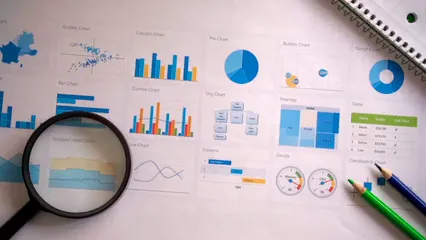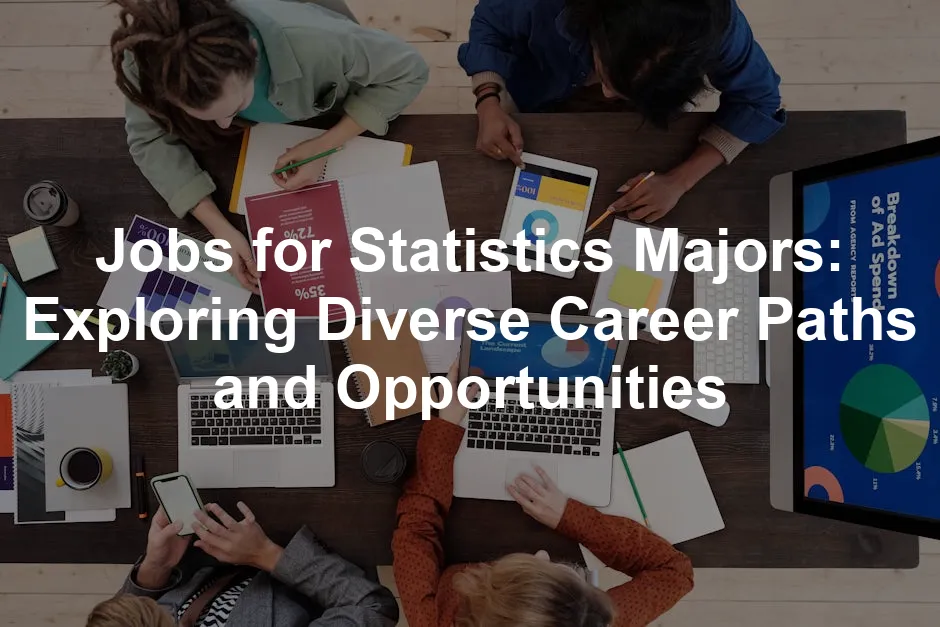Introduction
In our data-driven universe, statistics reign supreme. These number crunchers hold the keys to understanding vast amounts of information. Their skills don’t just crunch numbers; they illuminate trends, inform decisions, and guide strategies across industries. From healthcare to finance and even tech, statistics are everywhere.
If you’re a statistics major, get ready for a world of career opportunities. The skills you acquire open doors in numerous fields, allowing you to choose your own adventure. Want to analyze consumer behavior? You can be a market research analyst. Curious about public health? How about a biostatistician? The options are as diverse as they are exciting!
This article aims to equip you with insights into potential jobs, essential skills, and salary expectations for statistics graduates. Let’s explore the exciting world of statistics careers, where your numbers can make a big difference!
The Value of a Statistics Degree
A degree in statistics offers a treasure trove of skills. First up, data analysis. You learn to sift through mountains of numbers, extracting meaningful insights. Then there’s critical thinking, where you connect the dots and make data-driven decisions. These skills are not just academic; they’re essential in the real world.

Healthcare is one sector where statisticians shine. They analyze patient data to improve treatment outcomes. In finance, you’ll find statistics majors assessing risks and guiding investments. Technology companies employ data scientists to glean insights from user behavior. The possibilities are endless. Speaking of insights, you can deepen your knowledge with R Programming for Data Science. This book is a fantastic resource to master the programming language that powers data analysis!
But wait, there’s more! According to the Bureau of Labor Statistics, the demand for statisticians is projected to grow by 34% over the next decade. That’s significantly higher than the average for all occupations. This surge is fueled by the increasing reliance on data in decision-making. So, if you’re considering a career in statistics, you’re stepping into a field ripe with opportunities.
In summary, a statistics degree is not just a piece of paper; it’s a passport to a fulfilling career. With strong analytical skills and a knack for problem-solving, you’ll find yourself in high demand across various industries. Statisticians are the unsung heroes who turn data into actionable insights, and the world needs more of them!

Top Career Paths for Statistics Majors
Data Analyst
Data analysts are the superheroes of the data world. They collect, process, and perform statistical analyses on large datasets. Their primary responsibility? Turning raw data into actionable insights that help businesses make informed decisions. They create reports and dashboards that visualize trends and patterns, making the complex world of data digestible to everyone.
To thrive in this role, proficiency in statistical software is a must. Think R, Python, and SQL. Familiarity with data visualization tools like Tableau or Power BI can also be a significant advantage. A strong analytical mindset, attention to detail, and good communication skills are key. After all, you need to explain your findings to people who might not speak “data.” Plus, if you’re looking to get started with data visualization, check out Tableau for Beginners to get a head start!

The median salary for data analysts hovers around $74,822. According to the Bureau of Labor Statistics, job growth in this field is projected at a healthy rate of 25% over the next decade. So, if you love numbers and storytelling, a data analyst role could be your perfect fit!
Data Scientist
If data analysts are the superheroes, data scientists are the wizards. They use advanced analytical techniques and machine learning algorithms to solve complex problems. Data scientists work with massive datasets, building predictive models and employing statistical methods to extract valuable insights. Their work is pivotal in driving strategic business decisions.
To succeed as a data scientist, you’ll need strong programming skills, particularly in languages like Python and R. Knowledge of machine learning, data wrangling, and statistical modeling are also essential. The ability to communicate complex ideas in simple terms is a plus. To get started, consider picking up a copy of Data Science from Scratch. This book is a great way to build your foundation!

Now, let’s talk salary. Data scientists can expect to earn a median salary of around $100,910. The job outlook is bright, with a projected growth rate of 31% over the next decade. If you’re excited about turning data into magic, this could be the path for you!
Statistician
Statisticians are the backbone of research and analysis across various sectors. They design experiments, collect data, and interpret results to help organizations make data-driven decisions. From public health to market research, statisticians play a crucial role in understanding and solving real-world problems.
To excel in this career, you need a solid understanding of statistical methods and software. Mastery of tools like SAS and SPSS can be beneficial. Strong analytical skills and attention to detail are paramount, as is the ability to communicate findings clearly. If you’re looking to enhance your statistical analysis skills, consider SPSS Statistics for Data Analysis. It’s a great resource to get you started!
The median salary for statisticians is approximately $96,280, and job growth is projected at 33% over the next decade. If you enjoy solving puzzles and have a passion for data, being a statistician might be your calling! Learn more about the role of statisticians and their impact.
Actuary
Actuaries are the financial risk assessors, using mathematical and statistical methods to evaluate risks and uncertainties. They typically work in insurance, pensions, and finance, helping organizations make sound decisions based on their analyses.
To become an actuary, strong mathematical skills are essential. Most actuaries hold a bachelor’s degree in mathematics, statistics, or actuarial science. Additionally, obtaining professional certification is a common requirement. Actuaries must also possess excellent problem-solving skills and the ability to communicate complex concepts effectively. If you want to dive deeper into financial analysis, Financial Modeling for Dummies is an excellent place to start!
The median salary for actuaries is about $105,900, with a job outlook projected to grow by 24% over the next decade. If you enjoy numbers and risk management, this could be an incredibly rewarding career path!
Biostatistician
Biostatisticians are the unsung heroes of healthcare. They analyze data from clinical trials and health studies, ensuring treatments are effective and safe. Every time a new medicine hits the market, you can bet a biostatistician played a crucial role in validating its efficacy.
Their responsibilities include designing experiments, collecting data, and interpreting results to draw meaningful conclusions. They work closely with researchers and healthcare professionals to ensure the accuracy of findings.
To excel in this role, strong knowledge of health-related statistics is essential. Familiarity with statistical software like R or SAS is also crucial. Communication skills are a must, as biostatisticians often present complex data to non-statistical audiences. If you’re keen on diving into the world of biostatistics, grab a copy of Biostatistics for the Biological and Health Sciences to strengthen your foundation!
The median salary for biostatisticians is around $114,610, reflecting the high demand for their expertise. The job outlook is promising, with growth expected as the healthcare sector continues to expand. With the world increasingly relying on data to inform health decisions, biostatisticians are set to remain in demand.

Financial Analyst
Financial analysts are the financial detectives of the business world. They sift through mountains of financial data to help companies and individuals make informed investment choices. Their expertise is vital in navigating the often-turbulent waters of financial markets.
These analysts analyze financial statements, monitor market trends, and evaluate investment opportunities. They provide insights that guide the financial strategies of businesses and help individuals make the most of their investments.

To thrive in this position, an understanding of financial markets and statistics is indispensable. Proficiency in tools like Excel and financial modeling software can set candidates apart. Strong analytical skills and attention to detail are essential, as small errors can lead to significant financial consequences. If you want to dive deeper into data analysis, consider picking up Excel Data Analysis: Your visual blueprint for creating and analyzing data. It’s a great resource!
The median salary for financial analysts is approximately $95,570, with a steady job outlook as businesses increasingly rely on data-driven financial strategies. As the complexity of financial markets grows, so does the need for skilled financial analysts.

Market Research Analyst
Market research analysts are the pulse-checkers of the business world. They gather and analyze data on consumer preferences, helping companies understand what makes their customers tick. Armed with this information, businesses can tailor their products and marketing strategies effectively.
Their responsibilities include conducting surveys, analyzing market trends, and interpreting data to provide actionable insights. They often collaborate with marketing teams to develop strategies that resonate with consumers. If you’re interested in mastering the nuances of market research, check out Market Research Essentials. It’s a superb guide to get you started!

The median salary for market research analysts is around $69,706, with a job outlook projected to grow by 13% over the next decade. As businesses continue to prioritize consumer insights, market research analysts will remain in high demand.
Operations Research Analyst
Operations research analysts are the problem-solvers of organizations. They use mathematical methods and statistical analysis to optimize processes and improve efficiency. If a company has a complex problem, these analysts are often the key to finding a solution.
Their responsibilities include analyzing data to identify operational inefficiencies, developing mathematical models, and recommending improvements. They work across various sectors, from manufacturing to logistics, ensuring that organizations run smoothly.

To excel in this role, strong analytical and problem-solving skills are essential. Familiarity with optimization techniques and statistical software is also important. Communication skills come into play, as analysts need to convey their findings to decision-makers. If you’re keen to learn more about optimization, consider The Analytics Lifecycle Toolkit for a detailed guide!
The median salary for operations research analysts is about $82,360, with a job outlook expected to grow by 23% in the coming years. As organizations increasingly focus on efficiency, the demand for operations research analysts will continue to rise.

Additional Career Options
A statistics degree opens the door to a variety of career options beyond the big names. Business analysts, quality assurance analysts, and educators are just a few paths available. Each role leverages the analytical skills gained through a statistics education.
Business analysts utilize data to enhance decision-making processes within organizations. Quality assurance analysts apply statistical methods to improve product quality and ensure compliance with standards. Teaching positions offer the chance to inspire the next generation of statisticians. Interested in furthering your teaching skills? Consider The Data Science Handbook to enhance your knowledge!
The versatility of a statistics degree makes it a valuable asset in many fields. From finance to healthcare and beyond, the skills of a statistics major are in high demand. With the right expertise, graduates can carve out successful careers in various industries, making their mark in the data-driven world.

Skills and Qualifications Required
Statistics majors unlock a world of opportunities, but certain skills and qualifications are essential to thrive in this field. From technical proficiencies to soft skills, the right mix can set you apart in a competitive job market.
Essential Skills
To start, let’s highlight the key technical skills vital for statistics majors. Data manipulation is a biggie. You’ll need to work with large datasets, cleaning and organizing data for analysis. Statistical analysis is another cornerstone. Mastering tools like R, Python, and SQL is crucial. These programming languages enable you to perform complex analyses and derive meaningful insights. If you’re looking to enhance your data analysis skills, check out Data Analysis with R for a comprehensive guide!

But it’s not all about numbers! Soft skills are equally important. Communication skills are a must. You’ll need to translate complex data findings into digestible insights for non-technical audiences. Teamwork also plays a key role. Many projects require collaboration with cross-functional teams. Building rapport and working well with others can be the secret sauce for success.
Additionally, problem-solving skills will serve you well. Statistics is all about making sense of data-driven dilemmas, so being able to think critically and approach challenges creatively is essential. If you’re keen to dive deeper into statistical methods, consider Statistical Methods for the Social Sciences for more insights!
In summary, the right blend of technical and soft skills can help statistics majors excel in various industries. The demand for these skills ensures that graduates can find fulfilling careers equipped to tackle real-world issues.
Educational Requirements
When it comes to educational qualifications, a bachelor’s degree in statistics or a related field is typically the starting point. This foundational degree equips you with essential analytical skills and statistical knowledge. However, many employers prefer candidates with a master’s degree, particularly for specialized roles like biostatistics or data science.
For those looking to climb the academic ladder, pursuing a PhD can open the door to academia or advanced research positions. A doctoral degree may be necessary for roles in teaching at the university level or conducting high-level research.
Certifications can also enhance your qualifications. Organizations like the Royal Statistical Society offer professional memberships that can bolster your resume. Additionally, pursuing certifications in statistical software, such as SAS or SPSS, can make you more attractive to employers. Learn about troubleshooting SPSS for better performance.
Lastly, don’t overlook the value of continuous professional development. Workshops, online courses, and conferences can help you stay updated on the latest tools and techniques in the field. Embracing lifelong learning will keep your skills sharp and relevant. If you’re looking for a great online course, consider Data Science for Dummies. It’s a perfect introduction!
In conclusion, while a solid educational foundation is critical, pursuing advanced degrees and certifications can significantly increase your employability and career prospects in the ever-evolving field of statistics.

Job Search Strategies for Statistics Graduates
Looking for a job as a statistics major? You’re not alone! Many graduates share the same quest for that perfect role. Here are some effective strategies to help you stand out in the job market.
Build a Strong Resume and Cover Letter
Your resume is your first impression. Make it count! Tailor your resume and cover letter for each application. Highlight your statistical skills, software proficiency, and relevant coursework. Use numbers to showcase your achievements. For instance, did you increase efficiency by 20% in a project? Mention it!
Include internships, research projects, or relevant volunteer work. Employers love to see practical experience. Don’t forget to proofread! A few typos can send your resume straight to the recycling bin.

Networking Strategies
Networking is crucial in today’s job market. Join professional associations, like the American Statistical Association (ASA) or the Royal Statistical Society (RSS). These groups offer workshops, conferences, and networking events. Attending industry conferences can also be a game-changer.
Connect with professionals, ask questions, and share your aspirations. Don’t hesitate to reach out on platforms like LinkedIn. A simple “Hello” can lead to opportunities you didn’t expect.

The Power of Internships
Internships are your golden ticket to gaining real-world experience. They provide a chance to apply your skills, meet industry professionals, and build your resume. Many statistics programs offer internship placements, but if yours doesn’t, take the initiative.
Look for internship opportunities at local companies or government agencies. Even volunteering for non-profits can give you valuable experience. Remember, every bit of experience counts. And speaking of experience, consider picking up How to Measure Anything: Finding the Value of “Intangibles” in Business. It’s a great read!
In short, building a strong resume, networking effectively, and seeking internships can significantly enhance your employability. The job market may seem daunting, but with these strategies in your toolkit, you’re well on your way to landing that dream job!
FAQs
What are the most common industries that hire statistics graduates?
Statistics graduates are in demand across various industries. Common sectors include finance, healthcare, government, and technology. Each field values the ability to analyze data and make informed decisions.
Is a graduate degree necessary for a career in statistics?
The educational requirements vary by role. Many entry-level positions require a bachelor’s degree. However, advanced roles often prefer or require a master’s or PhD.
How can I increase my chances of landing a job in statistics?
Gain relevant experience through internships and projects. Building a solid professional network is crucial. Attend industry events and connect with professionals in your field.
What skills should I focus on developing as a statistics major?
Focus on developing technical skills like data manipulation, statistical analysis, and programming. Also, soft skills like communication and teamwork are essential for effective collaboration.
What is the average salary for statistics majors?
Salaries vary by role and industry. On average, statistics graduates earn between $63,920 (Market Research Analyst) and $114,610 (Biostatistician). The outlook is promising, with many roles offering competitive salaries.
Please let us know what you think about our content by leaving a comment down below!
Thank you for reading till here 🙂
All images from Pexels




